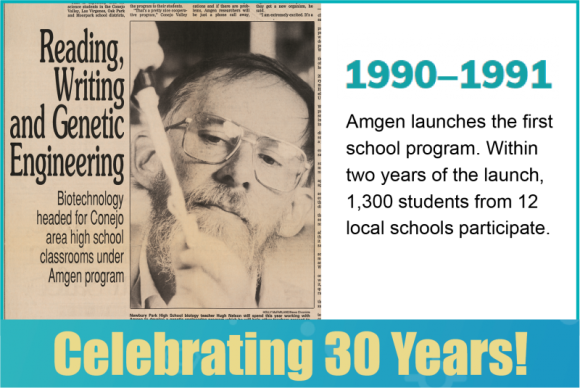In honor of the Amgen Biotech Experience’s (ABE) 30th anniversary this year, veteran ABE teachers Winnie Litten and Ann Cortina recently shared their stories about the early days working with the program and some of the changes they have seen along the way. Both have fond memories of working with Hugh Nelson, who was the first ever ABE teacher and who helped develop the program.
“Back in those days, when I needed to pick up supplies for the lab, I would drive onto the Amgen campus and park right in front of a building,” says Litten, a teacher at Oak Park High School in Southern California. “I would always bring Hugh a banana for a snack, we would just get a cart, wheel it into a lab room/supply room, and start pulling things off the shelves. It was like going to a grocery store. I need a little agar, a few bacteria, a few pipettes … unbelievable to think about now. Who gets to do their shopping at Amgen?”
Similarly, Cortina remembers driving 70 miles through Los Angeles area traffic to Newbury Park, Calif., to pick up the kits for a new biotech program she was going to teach in her classroom at West High School. “It's a good thing I had this large van because the equipment I needed to carry out the labs literally filled it,” she recalls. “The incubator was about 3-foot square and had to weigh well over 100 pounds. The thermocycler was equally huge as was the centrifuge. I asked myself, on the way home, what I was getting myself into.”
Now, the program has expanded to more than 160 schools in the Los Angeles area alone and nearly 1,000 schools worldwide. Like so many teachers worldwide, Litten and Cortina have enjoyed seeing the growth of the program and the growth within their students.
“I was sold on ABE after the first year I participated because I saw its ability to interest and engage students,” Cortina says.
Indeed, Litten says, “This program gives me the distinct privilege of watching the pride on my students’ faces as they learn pipetting techniques, cutting, ligating, separating DNA, and transforming a living organism because of what they did, what they understand, and what they can apply.”
